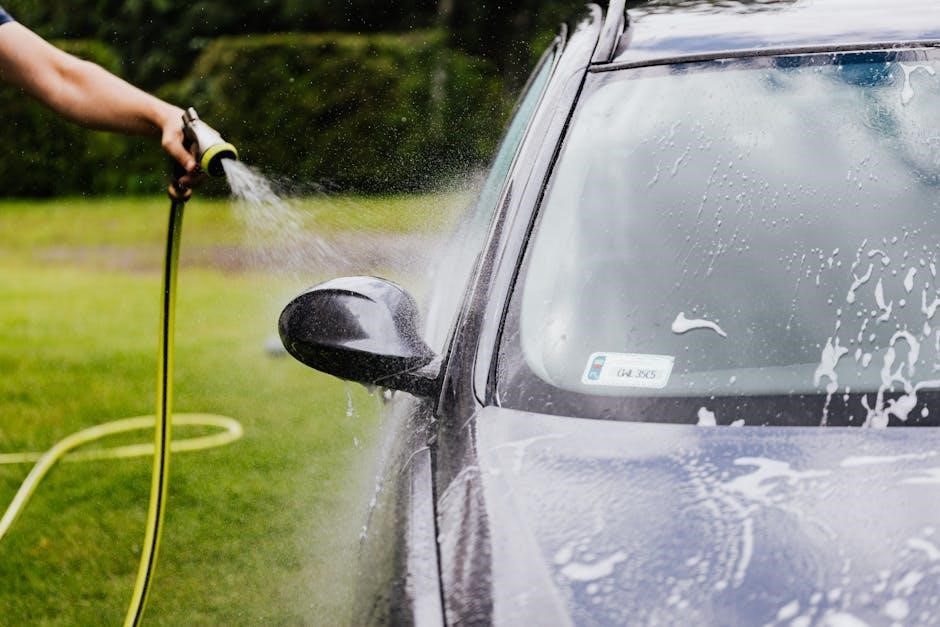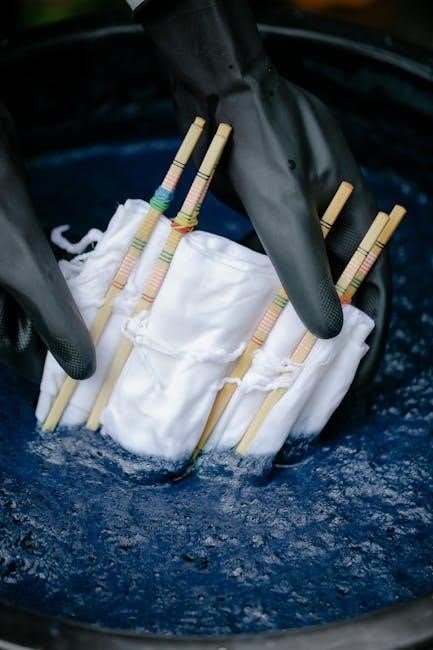Kenmore 420 Water Softener Manual Overview
The Kenmore 420 Water Softener manual provides comprehensive guidance for installation‚ operation‚ and maintenance. It includes safety tips‚ step-by-step setup instructions‚ and troubleshooting solutions to ensure optimal performance and longevity of the system.
The Kenmore 420 Water Softener is part of the IntelliSoft series‚ designed to provide efficient and reliable water softening solutions for homes. Known for its high-performance valve and intuitive design‚ this system is tailored to reduce hard water issues effectively. The manual serves as a comprehensive guide‚ covering installation‚ operation‚ and troubleshooting‚ ensuring users can maintain optimal performance. It emphasizes safety‚ step-by-step setup‚ and regular maintenance tasks to prolong the system’s lifespan. With features like advanced programming and salt storage management‚ the Kenmore 420 is a user-friendly option for improving water quality. Whether addressing common problems or scheduling professional care‚ this softener is built to enhance household comfort and appliance longevity. The manual is a valuable resource for both new and experienced users‚ offering clear instructions and expert tips to maximize the system’s benefits.
Key Features of the Kenmore 420 Series
The Kenmore 420 Series water softener is equipped with a high-performance valve‚ designed to optimize water flow and efficiency. It features advanced programming options‚ allowing users to customize settings for optimal softening performance. The system includes a bypass valve for easy maintenance and a large salt storage tank‚ ensuring minimal refills. The IntelliSoft technology enables intelligent recharging‚ reducing salt usage and energy consumption. The softener also includes a resin tank that effectively removes hardness minerals‚ ensuring soft water throughout the home. With its durable construction and user-friendly interface‚ the Kenmore 420 Series is designed to provide long-lasting results and hassle-free operation. Its compact design makes it suitable for various installation spaces‚ while its high-capacity performance caters to both small and large households. These features collectively make the Kenmore 420 Series a reliable and efficient solution for addressing hard water issues.
Understanding the Manual Structure

The Kenmore 420 Water Softener Manual is organized into clear‚ logical sections to help users navigate and understand the system. It begins with an introduction to the water softener‚ followed by key features and installation instructions. The manual then delves into maintenance and troubleshooting‚ ensuring users can address common issues independently. Each section is divided into subheadings for easy reference‚ with detailed explanations and step-by-step guides. Visual aids‚ such as diagrams‚ are included to simplify complex processes. The manual also provides a glossary of terms and a troubleshooting index for quick solutions. By structuring the content in this way‚ the manual caters to both new and experienced users‚ ensuring they can find the information they need efficiently. This user-friendly approach makes the Kenmore 420 Manual an invaluable resource for optimizing and maintaining the water softener system.

Installation and Setup
Installation and setup of the Kenmore 420 Water Softener involve shutting off the water supply‚ connecting pipes‚ and initializing the system. Follow detailed step-by-step instructions for a smooth process.

Step-by-Step Installation Guide
Installing the Kenmore 420 Water Softener requires careful planning and adherence to the manual instructions. Begin by shutting off the main water supply and draining the pipes. Locate a suitable installation site near the water supply line‚ ensuring easy access for maintenance. Mount the softener and brine tank securely on a level surface. Connect the inlet and outlet valves to the water supply lines‚ ensuring proper alignment to avoid leaks. Next‚ attach the drain line to a nearby drain or floor drain‚ following local plumbing codes. Finally‚ plug in the power cord and initialize the system by running a regeneration cycle. Double-check all connections for leaks and ensure the system operates quietly. Refer to the manual for specific torque settings and connection sizes to avoid damage. Proper installation ensures optimal performance and longevity of the water softener. Always follow safety precautions when handling tools and water lines.
System Components and Compatibility
The Kenmore 420 Water Softener system consists of several key components‚ including the resin tank‚ control valve‚ brine tank‚ and drain line. The resin tank holds the ion-exchange resin responsible for removing hardness minerals‚ while the control valve manages water flow and regeneration cycles. The brine tank stores salt used during regeneration. For compatibility‚ the system is designed to work with standard plumbing systems‚ typically requiring 1-inch connections. It is compatible with PVC‚ PEX‚ or copper pipes‚ making it versatile for various home setups. The softener is also compatible with most water pressure ranges‚ up to 80 PSI‚ and operates effectively in temperatures between 40°F and 120°F. Ensure the system is installed on a level surface to maintain balance and functionality. Additional accessories‚ such as a bypass valve or remote monitor‚ can enhance convenience but are not required for basic operation. Always refer to the manual for specific compatibility details.
Pre-Installation Checks and Requirements
Before installing the Kenmore 420 Water Softener‚ ensure you complete several essential checks and meet specific requirements. First‚ assess the water hardness level in your home to determine the optimal settings for the softener. Measure the space where the unit will be installed to confirm it fits comfortably. The system requires a power source nearby‚ typically a 120V outlet‚ and a drain for regeneration water. Check local plumbing codes to ensure compliance. Inspect your plumbing system for leaks or damage before connecting the softener. A bypass valve is recommended to allow easy maintenance without disrupting water supply. Drain placement is critical; it must be at least 1.5 feet above the floor to ensure proper drainage. Additionally‚ ensure the area is level and stable to prevent system imbalance. Finally‚ verify the salt storage capacity and plan for regular salt replenishment. Addressing these pre-installation requirements ensures a smooth and efficient setup process for your water softener system.
Connecting the Water Softener to Your Plumbing
Connecting the Kenmore 420 Water Softener to your plumbing system requires careful planning and execution to ensure proper function and water flow. Start by identifying the inlet and outlet ports on the softener‚ which are typically labeled as “In” and “Out.” These ports connect to your home’s water supply lines. Use high-quality connectors and tubing to prevent leaks and ensure a secure fit. The softener must be installed in the correct direction of water flow‚ as indicated in the manual. A bypass valve is included to allow for easy servicing without interrupting water supply to the house. Connect the valve according to the manufacturer’s instructions. Additionally‚ ensure the drain line is properly attached to a nearby drain or floor drain‚ as the system requires a place to discharge regeneration water. Double-check all connections for tightness before turning on the water supply. Proper installation ensures efficient operation and prevents potential water damage or system malfunction.
Post-Installation Tests and Adjustments
After installing the Kenmore 420 Water Softener‚ perform a series of tests to ensure proper functionality and make necessary adjustments. Begin by checking all connections for leaks‚ ensuring the system is watertight. Next‚ test the water hardness levels using a test kit to confirm the softener is effectively reducing mineral content. Flush the system by running several gallons of water through the softener to remove any debris or air pockets. Check the bypass valve to ensure it is in the correct position and functioning properly. Adjust the pressure settings if needed‚ based on your home’s water pressure requirements. Finally‚ monitor the system’s performance over the first few weeks‚ paying attention to water flow‚ salt usage‚ and softening efficiency. If issues arise‚ refer to the troubleshooting section or contact Kenmore support for assistance. These post-installation checks ensure the water softener operates efficiently and provides optimal results for your home’s water supply.

Maintenance and Care
Regular upkeep ensures optimal performance of the Kenmore 420 Water Softener. Schedule periodic checks‚ clean components‚ and replenish salt to maintain efficiency and extend system lifespan for consistent soft water quality.
Regular Maintenance Tasks

Regular maintenance is crucial for the Kenmore 420 Water Softener to ensure optimal performance and longevity. Start by monitoring salt levels in the storage tank to prevent depletion‚ as this directly affects water softening capability. Check the brine tank monthly and clean it every 3-6 months to remove dirt and debris. Inspect the resin tank for visible wear or leaks‚ replacing it if necessary. Flush the system every 1-2 months to clear mineral buildup and improve efficiency. Additionally‚ clean the venturi valve and flow restrictor annually to maintain proper water flow. Lubricate moving parts like the rotor and seals to prevent friction damage. Finally‚ test the water hardness periodically to confirm the system is functioning correctly. By following these routine tasks‚ you can prevent issues and enjoy soft‚ conditioned water consistently. Always refer to the manual for specific guidance on these procedures to ensure they are performed safely and effectively.
Cleaning and Replacing the Resin Tank
Cleaning and replacing the resin tank in your Kenmore 420 Water Softener is essential for maintaining its efficiency. The resin tank should be cleaned every 5-7 years or when you notice a decline in water softening performance. Start by turning off the water supply and draining the tank. Disconnect the tank from the system and remove any remaining water. Use a soft-bristle brush and mild detergent to scrub away resin beads and mineral buildup. Rinse thoroughly and allow the tank to dry before reconnecting it. If the tank is damaged or shows signs of wear‚ replace it with a compatible Kenmore resin tank. Always follow the manufacturer’s instructions for replacement to ensure proper installation. Regular cleaning and replacement of the resin tank will help maintain soft water quality and extend the lifespan of your Kenmore 420 Water Softener.
Maintaining the Salt Storage Tank
Maintaining the salt storage tank of your Kenmore 420 Water Softener ensures optimal performance and prevents issues like salt bridges or blockages. Start by cleaning the tank every 6-12 months. Use a clean scoop or cup to remove any remaining salt‚ then wipe the interior with a mild detergent and warm water. Rinse thoroughly to avoid residue. Check the salt level regularly and refill as needed‚ but avoid overfilling to prevent spillage. Use high-quality water softener salt or potassium chloride pellets for best results. Inspect the tank for any signs of moisture or humidity‚ as these can cause clumping. If you notice a salt bridge‚ carefully break it up using a broom handle or similar tool. Finally‚ ensure the tank is always placed on a stable‚ level surface to prevent tipping. Regular maintenance of the salt storage tank will ensure consistent soft water and extend the lifespan of your Kenmore 420 Water Softener.
Sanitizing the Water Softener System
Sanitizing your Kenmore 420 Water Softener System is crucial to maintain water quality and prevent bacterial growth. Start by turning off the water supply and draining the system. Mix 1 cup of unscented chlorine bleach or 1 gallon of hydrogen peroxide with 5 gallons of water in a bucket. Pour the solution into the salt storage tank and allow it to flow through the system for 10-15 minutes. This ensures the sanitizer reaches all components‚ including the resin bed and valves. Afterward‚ flush the system by running several gallons of water through your household faucets to rinse out the solution. Repeat this process every 6-12 months or if you notice unusual odors or tastes in the water. Sanitizing helps maintain the efficiency of your water softener and ensures safe‚ clean drinking water. Always follow safety precautions when handling bleach or other sanitizing agents.
Scheduling Professional Maintenance

Scheduling professional maintenance for your Kenmore 420 Water Softener ensures optimal performance and extends its lifespan. It is recommended to have your system serviced annually by a certified technician. During these visits‚ professionals will inspect the resin bed‚ check valve functionality‚ and ensure all settings are correctly calibrated. They will also assess salt usage‚ clean or replace internal components if necessary‚ and verify that the system is operating efficiently. Professional maintenance is especially important if you notice a decline in water quality or system performance. Always use Kenmore-authorized service providers to guarantee compatibility and adherence to manufacturer guidelines. Regular professional check-ups can prevent costly repairs and ensure your water remains soft and free of contaminants. Refer to the manual for contact information or visit the Kenmore website to schedule an appointment. Proactive maintenance is key to maintaining your water softener’s effectiveness and reliability over time.

Troubleshooting Common Issues
The Kenmore 420 Water Softener Manual provides detailed guidance for identifying and resolving common problems‚ ensuring smooth operation and addressing potential issues promptly for optimal water quality and system performance.
Water Not Softening: Possible Causes and Solutions
If your Kenmore 420 water softener isn’t producing soft water‚ several factors could be at play. First‚ check the salt levels in the brine tank; an empty or low-salt condition prevents proper regeneration. Ensure the salt is high-quality and free from impurities‚ as poor salt can cause inefficiencies. Next‚ verify the system’s settings‚ such as the hardness level and water usage‚ to ensure they match your household needs. Incorrect settings may result in under- or over-treatment of water. Additionally‚ inspect the resin tank for issues like resin degradation or blockages‚ which can hinder softening performance. If the bypass valve is accidentally left open‚ it may bypass the softening process altogether. Finally‚ check for error codes on the control panel‚ as they can indicate specific malfunctions. Addressing these issues promptly will restore soft water flow and maintain system efficiency. Always refer to the manual for detailed troubleshooting steps or contact Kenmore support for assistance.
Dealing with Salt Bridges and Blockages
A salt bridge or blockage in your Kenmore 420 water softener can disrupt the regeneration process‚ leading to hard water issues. A salt bridge forms when salt crystallizes at the top of the brine tank‚ creating a hard crust that prevents water from dissolving the salt below. To address this‚ carefully break the salt crust using a sturdy object like a broom handle or scoop. Avoid damaging the tank or the float assembly. Once the bridge is removed‚ clean the tank thoroughly and refill it with high-quality salt. Regularly inspecting the brine tank and ensuring proper salt levels can prevent future bridges. If blockages persist‚ check the salt intake or distribution system for obstructions. Always follow the manual’s guidelines for maintenance to keep your water softener functioning optimally. Addressing these issues promptly ensures consistent soft water delivery and extends the system’s lifespan.
Resin Tank Issues and Solutions
The resin tank in your Kenmore 420 water softener is crucial for removing minerals that cause water hardness. Over time‚ issues such as resin degradation or channeling can reduce the system’s efficiency. If you notice a decrease in water softness‚ inspect the resin tank for visible damage or contamination. Cleaning the resin bed with a softener cleaner can often resolve minor issues. For more severe problems‚ replacing the resin may be necessary. Ensure the replacement resin is compatible with your Kenmore 420 model. Proper maintenance‚ such as regular salt level checks and avoiding excessive water pressure‚ can prevent resin tank damage. If channeling occurs‚ where water flows through a single path in the resin‚ it can be addressed by redistributing the resin or replacing it. Always follow the manual’s guidelines for handling and cleaning the resin tank to maintain optimal performance and extend its lifespan.
Understanding and Fixing Error Codes
The Kenmore 420 water softener is equipped with an error code system to help identify and resolve operational issues. Common error codes include EC1‚ EC2‚ and EC3‚ each corresponding to specific problems such as power supply issues‚ water flow disruptions‚ or communication errors between components. To address these codes‚ refer to the manual for detailed explanations and step-by-step solutions. For instance‚ EC1 may indicate a power outage or faulty electrical connection‚ while EC2 could signal a blockage in the water supply lines. EC3 often relates to issues with the control valve or resin tank communication. Resetting the system by turning it off and on or checking the salt levels can sometimes resolve these errors. If problems persist‚ consult the troubleshooting guide or contact Kenmore customer support for professional assistance. Regular system checks and maintenance can help prevent error codes from occurring in the first place.

Additional Resources
Explore online guides‚ official Kenmore websites‚ and customer support for detailed assistance. Community forums and FAQs offer troubleshooting tips and user experiences‚ ensuring comprehensive support for your water softener needs.
Online Guides and Tutorials
The Kenmore 420 Water Softener manual is supported by a variety of online resources to help users understand and maintain their system. Official Kenmore websites provide downloadable PDF manuals‚ installation videos‚ and step-by-step guides for troubleshooting common issues. Additionally‚ third-party plumbing websites and YouTube channels offer detailed tutorials on topics like system setup‚ salt tank maintenance‚ and resin replacement. These guides often include visual aids and interactive content‚ making complex procedures easier to follow. Many online forums and DIY communities also share user-generated tips and solutions for optimizing the water softener’s performance. Whether you’re a new user or an experienced homeowner‚ these online resources offer invaluable assistance in keeping your Kenmore 420 running smoothly. Regularly updated content ensures you stay informed about the latest maintenance practices and technological advancements in water softening systems.
Kenmore Customer Support and Contact Information
Kenmore provides comprehensive customer support to assist users with their 420 Water Softener. For immediate help‚ you can contact their customer service team via phone at 1-800-4MY-HOME (1-800-469-4663). Additionally‚ live chat and email support options are available through the official Kenmore website. The website also features a dedicated support section with FAQs‚ troubleshooting guides‚ and downloadable resources. For technical issues or warranty inquiries‚ users can reach out to Kenmore’s parent company‚ Sears‚ at 1-800-847-5000. Representatives are available Monday through Saturday‚ from 7 AM to 7 PM CST‚ to address concerns and provide solutions; Kenmore also offers online support resources‚ including repair service scheduling and parts ordering. Whether you need assistance with installation‚ maintenance‚ or troubleshooting‚ Kenmore’s customer support team is equipped to help you maximize the performance of your water softener.

Community Forums and User Discussions
Community forums and user discussions provide valuable insights and support for Kenmore 420 Water Softener owners. Platforms like Reddit‚ Facebook Groups‚ and specialized appliance forums host active discussions where users share their experiences‚ tips‚ and solutions. These communities are ideal for troubleshooting issues‚ learning about best practices‚ and gaining advice from experienced users. Many threads focus on common topics such as resin tank maintenance‚ salt usage‚ and system optimization. Additionally‚ users often compare different Kenmore models‚ making these forums a great resource for those considering upgrades or seeking second opinions. By engaging in these discussions‚ you can tap into a wealth of knowledge and resolve issues more effectively. Active participation in these forums also allows you to contribute your own insights‚ helping others in the process. Overall‚ community forums are a valuable resource for enhancing your understanding and maximizing the performance of your Kenmore 420 Water Softener.



